20 Essential Dynamic Stretches For Runners
How do you warm-up before running? Do you use dynamic stretches?
To properly prepare for your training or a race, you should include dynamic stretches in your warm-up routine before running.
In this article, I will show you all the dynamic stretches for runners I personally use. I will also answer the most frequently asked questions.
What are dynamic stretches?
Dynamic stretches are controlled and repeating motions used to warm up. They raise body temperature, increase blood flow, and help bring oxygen to the muscles. They improve the maximum range of motions, as well as neuromuscular coordination.
Research has shown that dynamic stretching during a warm-up before a race improves performance, unlike static stretching which can negatively affect you and limit the body’s ability to react quickly.
In the following text, I will show you 20 dynamic stretches for runners and answer the most frequently asked questions.
Dynamic stretches for runners
Dynamic stretches prepare muscles, tendons, and joints for activities that require higher mobility or are more demanding than common, everyday movements.
1. Neck rotation
Neck rotation is an exercise that improves neck mobility and helps remove pain and stiffness of the neck while stretching neck muscles.

How to properly do neck rotation?
- Start by standing with your feet hip-distance apart, look straight ahead, and put your hands on your hips to keep your upper body straight.
- Turn your neck left and look over your left shoulder, then turn right and look over your right shoulder. Repeat the motion 5 times.
- Bend your neck forward, then side to side. Repeat the motion 5 times.
- Bend your head left, then right, Repeat the motion 5 times.
Tips for properly doing neck rotation
- Maintain your posture – keep your upper body straight, do not turn as you perform the exercise.
- As you bend your head side to side, do not raise your shoulders, keep them relaxed.
- Perform the exercise within the limits of comfort – do not make any sudden movements.
2. Arm circles
Arm circles are an exercise that improves shoulder mobility by stretching and strengthening the muscles of the shoulder.

How to properly do arm circles?
- Start by standing with your feet hip-distance apart, look straight ahead, and keep your upper body straight.
- Raise your left arm and make circular motions.
- Make 5 circular motions in both directions.
Repeat the exercise with your other arm.
Tips for properly doing arm circles
- Maintain your posture – keep your upper body straight, do not turn as you perform the exercise.
- Perform the exercise within the limits of comfort – do not make any sudden movements.
3. Torso rotation
Torso rotation is an exercise that activates your core by stretching and strengthening the external oblique muscles, chest muscles, and back muscles.
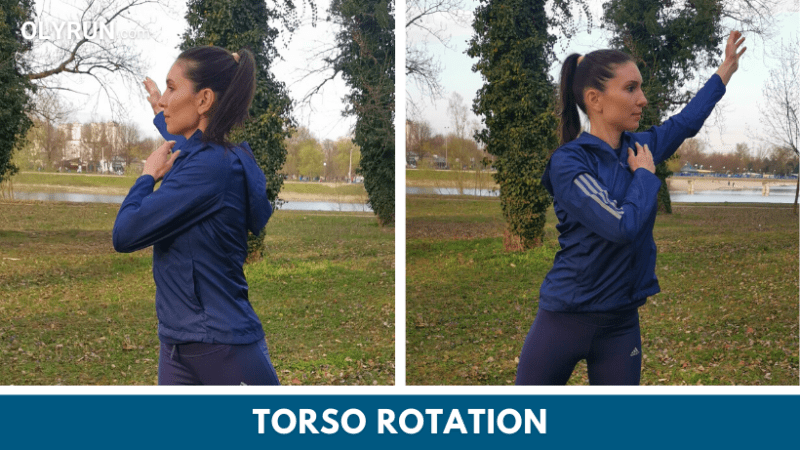
How to properly do torso rotation?
- Start by standing with your feet hip-distance apart, look straight ahead, and keep your upper body straight.
- Swing your left arm to the left, following it with your eyes. Put your right arm on the shoulder of the stretched arm.
- Swing your right arm to the right, following it with your eyes. Put your left arm on the shoulder of the stretched arm.
Repeat the motion 5-10 times.
Tips for properly doing torso rotation
- Maintain your posture – keep your upper body straight.
- Perform the exercise within the limits of comfort – do not make any sudden movements.
4. Standing side bend
The standing side bend is an exercise that stretches and strengthens abdominal muscles, activates your upper body, and improves your stability and posture.

How to properly do standing side bend?
- Start by standing with your feet hip-distance apart, put your hands on your hips, look straight ahead, and hold your body upright.
- Raise your left arm and bend to the right. Maintain the position for 3 seconds.
- Return to the starting position.
- Raise your right arm and bend to the left. Maintain the position for 3 seconds.
Repeat the motion 5 times.
Tips for properly doing standing side bend
- Maintain your posture – as you perform the exercise, one hand should be on your hip so that you can more easily control your posture.
- Perform the exercise within the limits of comfort – do not make any sudden movements.
5. Hip circles
Hip circles are one of the hip mobility exercises that improve hip mobility while stretching lower back muscles and strengthening the core.

How to properly do hip circles?
- Begin by standing with your feet hip-distance apart, hands on your hips, look straight ahead, and keep your upper body straight.
- Move your hips in a circular motion.
Do 10 reps of circular motions in both directions.
Tips for properly doing hip circles
- Maintain your posture – keep your body straight.
- Make as large circular motions as possible with your hips – start with smaller circular motions gradually increasing the volume.
6. Standing forward bend
The standing forward bend stretches your hamstrings and the lumbar area while activating your upper body.

How to properly do standing forward bend?
- Start by standing with your feet hip-distance apart, look straight ahead and hold your body upright.
- Raise both your arms and bend forward, trying to touch your feet.
- Maintain the position for 5 seconds and return to the starting position.
Repeat the motion 5 times.
Tips for properly doing standing forward bend
- Maintain your posture – do not bend your back, your spine should be in a neutral position.
- If you cannot reach your feet, slightly bend your knees to ease the burden on your lower back.
- Perform the exercise within the limits of comfort – do not make any sudden movements.
7. Straight leg swings
Straight leg swings are one of the hip mobility exercises that improve the mobility of hip flexors and extensors. They also activate the nervous system, which prepares you for a faster run.
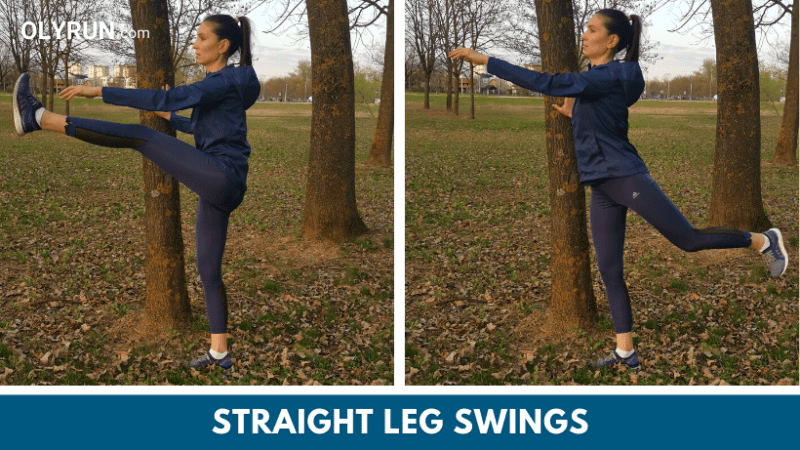
How to properly do straight leg swings?
- Stand next to your support (fence, tree, bench…) and hold it for balance during the exercise.
- Swing the left leg, stretched in the knee, forward then backward, standing fully on the right foot as you swing.
Do 10-15 reps, then repeat the exercise with the opposite leg.
Tips for properly doing straight leg swings
- Make sure you have enough space so that you can perform the full range of motion smoothly.
- Maintain your posture – keep your body straight, do not bend your back or turn your hips.
- Control your movements – avoid swinging your leg too high and avoid performing the exercise too quickly.
8. Side leg swings
Side leg swings are one of the hip mobility exercises that improve the mobility of the hip adductors and abductors.
These are the muscle groups used to move your leg toward or away from the midline of your body.

How to properly do side leg swings?
- Stand in front of your support (fence, tree, bench…) and hold it for balance during the exercise.
- Swing the left leg, stretched in the knee, to the left, and then to the right, standing fully on the right foot as you swing.
Do 10-15 reps, then repeat the exercise with the opposite leg.
Tips for properly doing side leg swings
- Make sure you have enough space so that you can perform the full range of motion smoothly.
- Maintain your posture – keep your body straight and do not bend your back.
- Control your movements – avoid swinging your leg too high and avoid performing the exercise too quickly.
9. Standing knee to chest
Standing knee to chest is one of the hip mobility exercises that improve hip mobility while increasing the flexibility of the glutes and the hamstrings.

How to properly do standing knee to chest?
- Begin by standing with your feet hip-distance apart, look straight ahead, and keep your upper body straight.
- Raise the left knee to the chest, standing fully on the right foot.
- Grab the raised knee with both hands, pulling it closer to the chest. Hold the position for 5-10 seconds.
- Slowly lower the left leg on the ground.
Do 10 reps, then repeat the exercise with the opposite leg.
Tips for properly doing standing knee to chest
- Maintain your posture – keep your body straight and do not bend your back (pull your knees towards your chest, not your chest towards your knees).
- Keep your support leg as straight as possible.
10. Heel grab
Heel grab is one of the hip mobility exercises that improve the mobility of your hips and ankles while also stretching your groin.

How to properly do heel grab?
- Begin by standing with your feet hip-distance apart, look straight ahead, and keep your upper body straight.
- Grab the left heel with both hands and pull it towards the opposite hip, standing fully on the right foot. Hold the position for 5-10 seconds.
- Slowly lower the left foot on the ground.
Do 5-10 reps alternately with each leg.
Tips for properly doing heel grab
- Maintain your posture – keep your body straight and do not bend your back.
- Keep your support leg as straight as possible.
11. Standing quad stretch
Standing quad stretch is an exercise that improves hip and ankle mobility, and stretches the quadriceps, hip flexor muscles, and the tibialis anterior.

How to properly do a standing quad stretch?
- Start by standing with your feet hip-distance apart, look straight ahead, and keep your upper body straight.
- With both of your hands, pull your left heel towards the glutes, standing fully on your right foot. Hold the position for 5-10 seconds.
- Slowly lower your left foot to the ground.
Repeat the motion 5-10 times with each leg.
Tips for properly doing standing quad stretch
- Maintain your posture – keep your upper body straight and do not bend your back.
- Make sure the whole foot of the front leg is on the ground.
- If you cannot maintain balance, use your free hand to grab a wall, a tree, or a bench until your core becomes stronger.
- Perform the exercise within the limits of comfort – do not make any sudden movements.
12. Single leg hip rotation
Single leg hip rotation is one of the hip mobility exercises that improve hip mobility and strengthen the glutes and the hamstrings, while also activating your core.

How to properly do single leg hip rotation?
- Begin by standing with your feet hip-distance apart, look straight ahead, and keep your upper body straight.
- Lift the left knee up to the hips, standing fully on the right foot.
- Move the left leg in a circular motion.
Do 10 reps in both directions, then do the exercise with the opposite leg.
Tips for properly doing single leg hip rotation
- Maintain your posture – keep your body straight and do not bend your back.
- Keep your support leg as straight as possible.
- Use your hands to maintain balance. For additional stability, use a support to make movement control easier.
13. The world’s greatest stretch
The world’s greatest stretch is one of the hip mobility exercises that improve hip mobility, stretch hip flexors, and your groin while strengthening your glutes.
That allows you to have longer stride length and better movement control.
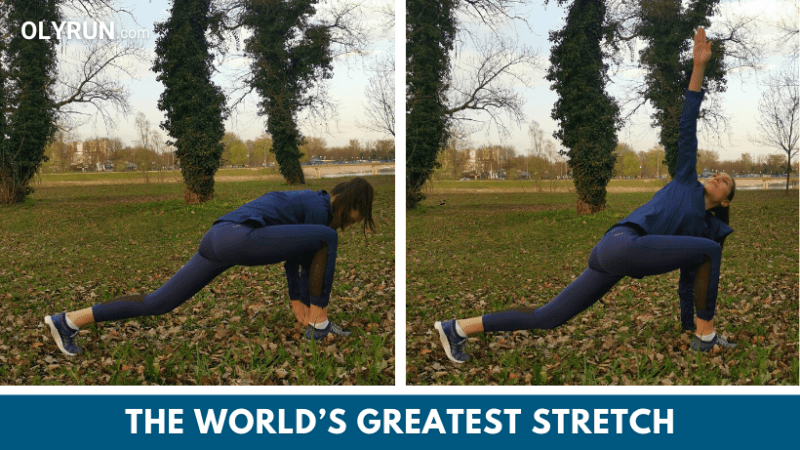
How to properly do the world’s greatest stretch?
- Begin by standing with your feet hip-distance apart, look straight ahead, and keep your upper body straight.
- Step forward with the left foot into a lunge. Put both of your palms on the ground, parallel to the left foot.
- The left elbow should be as close to the ground as possible.
- Extend the left arm upwards, following it with your eyes.
Repeat the motion 3-5 times, then repeat with the opposite side.
Tips for properly doing the world’s greatest stretch
- Maintain your posture – keep your body straight and do not bend your back.
- Make sure that your calf is perpendicular to the ground – your knee must not be in front of your foot.
- Make sure not to touch the ground with the knee of the back foot.
14. Hamstring sweep
The hamstring sweep is a dynamic exercise that helps improve the flexibility of your hamstrings by stretching and relaxing the muscles.

How to properly do a hamstring sweep?
- Begin by standing with your feet hip-distance apart, look straight ahead, and keep your upper body straight.
- Step forward with your left foot, with your weight on your heel.
- Bend forward and swing your arms so that you can feel the hamstrings tightening.
Repeat the exercise 5-10 times, while switching sides.
Tips for properly doing hamstring sweep
- The forward leg should be slightly bent in the knee to ease the burden on your lower back.
- Perform the exercise within the limits of comfort – do not make any sudden movements.
- Maintain your posture – keep your body straight and do not bend your back.
15. Dynamic calf stretch
Dynamic calf stretch is an exercise that helps improve ankle mobility by stretching the hamstrings and calves while strengthening calves, core, arm, shoulder, and feet muscles.

How to properly do dynamic calf stretch?
- Start with both of your palms and feet on the ground.
- Raise your left heel and put your right leg on the back of your left leg.
- Slowly lower your left heel towards the ground until you feel the slight tightening in your left calf muscles.
Repeat the motion 5 times and then repeat the exercise with the opposite side.
Tips for properly doing a dynamic calf stretch
- Maintain your posture – keep your body straight and do not bend your back.
16. Ankle Circles
Ankle circles is an ankle mobility exercise that relaxes the ligaments and tendons around the ankle.
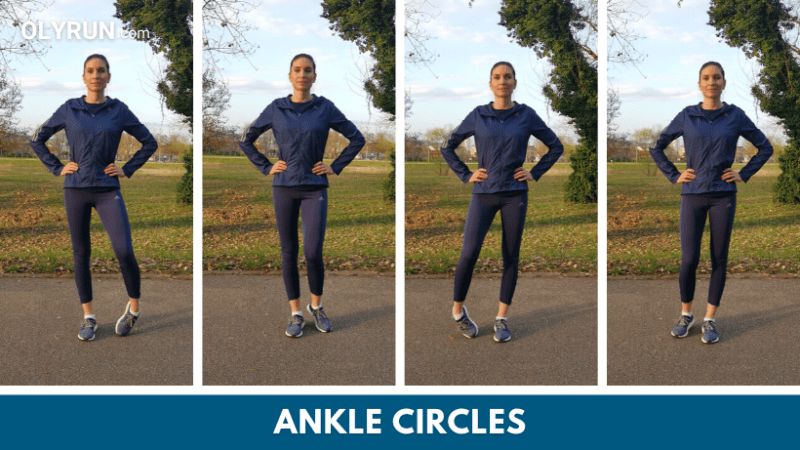
How to properly do ankle circles?
- Begin by standing with your feet hip-distance apart, look straight ahead, and keep your upper body straight.
- Do circular motions on the ankle of your left foot, leaning on your right foot.
- Do 10 circular motions in both directions.
Repeat the exercise with the other foot.
17. Dynamic hurdler stretch
The dynamic hurdler stretch improves hip flexibility and mobility by stretching the glutes, hamstrings, and hip abductors.
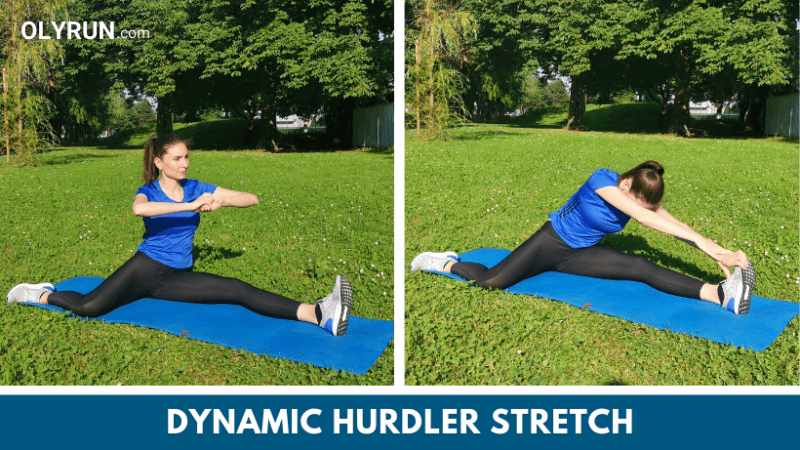
How to properly do dynamic hurdler stretch?
- Start by sitting, with your left leg stretched forward, and your right leg bent in the knee at a 90-degree angle. Also, your right leg should be at a 90-degree angle in relation to your left leg.
- Bend forward towards the stretched leg to feel the glutes and the hamstrings tightening. Maintain the position for 2-3 seconds.
- Return to the starting position.
Repeat the motion 5 times and then repeat the exercise with the opposite side.
Tips for properly doing dynamic hurdler stretch
- Maintain your posture – keep your body straight and do not bend your back.
- Perform the exercise within the limits of comfort – do not make any sudden movements.
- Pull the foot of your stretched leg towards you to stretch the glutes and the hamstrings even more.
18. Dynamic seated single leg hamstring stretch
The dynamic seated single leg hamstring stretch is an exercise that improves hip flexibility and mobility by stretching the glutes, hamstrings, and hip adductors.
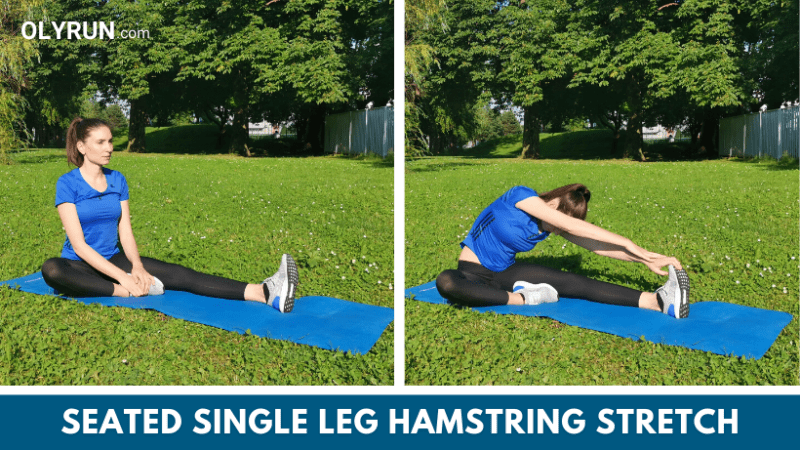
How to properly do dynamic seated single leg hamstring stretch?
- Start by sitting, with your left leg stretched forward, and your right leg bent in the knee with your right foot on the inner side of the opposite thigh.
- Bend forward towards the stretched leg to feel the glutes and the hamstrings tightening. Maintain the position for 2-3 seconds.
- Return to the starting position.
Repeat the motion 5 times and then repeat the exercise with the opposite side.
Tips for properly doing dynamic seated single leg hamstring stretch
- Keep your shoulders and your neck relaxed as you bend forward.
- Pull the foot of your stretched leg towards you to stretch the glutes and the hamstrings even more.
19. Dynamic butterfly
Dynamic butterfly is one of the hip mobility exercises that improve hip mobility, and stretch your groin, and hip adductors.

How to properly do dynamic butterfly?
- Sit in the starting position with your hands holding your feet together, knees spread out.
- With your elbows, apply light pressure to your knees, pushing them as close to the ground as possible. Repeat the motion 5 times.
- Hold the position for 10 seconds in the maximum range of motion.
Tips for properly doing dynamic butterfly
- Maintain your posture – keep your body straight and do not bend your back.
- Perform the exercise within the limits of comfort – do not make any sudden movements.
20. 90/90
90/90 is one of the hip mobility exercises that improve hip mobility, and stretch hip abductors and abductors while strengthening the glutes.

How to properly do 90/90?
- Start by sitting with your legs at a 90-degree angle, and both should be bent at the knee at a 90-degree angle.
- Lean forward so that you can feel your hips stretching. Hold the position for 5 seconds.
- Return the body to the original position and repeat the motion 5 times.
Repeat the exercise with the opposite side.
Tips for properly doing 90/90
- Maintain your posture – as you lean forward, do not bend your back, your upper body should be straight.
- Perform the exercise within the limits of comfort – do not make any sudden movements.
- Keep your knees on the ground as you perform the exercise.
Why should every runner do dynamic stretches?
Studies have shown numerous benefits of dynamic stretches.
1. Raise body temperature
Dynamic stretches for runners warm you up before activities because they raise your body temperature and prepare you for the upcoming exertion.
Research shows that proper warming up results in an increase in body temperature by 2-3% which lasts for 45 minutes. The increase in body temperature leads to useful changes in our muscles and tendons:
- Significantly boosts the elasticity of muscles and as a result, allows an exercise of higher intensity.
- Muscles and tendons become more flexible which makes stretching easier and more effective.
- Boost in enzymes and metabolic activities helps the effectiveness of muscle contractions.
2. Increase blood flow to your muscles
Dynamic stretches for runners prepare the cardiovascular system as well, by increasing the heart rate and improving circulation.
As a result, oxygen and other nutrients travel more easily to the muscles, which means that you will be able to withstand much more exertion.
3. Reduce the risk of injury
Dynamic stretches for runners will significantly reduce the risk of injury.
Warmed-up muscles are ready for contraction and have a lower likelihood of cramping, unlike cold muscles.
4. Prepare you mentally for training
Dynamic stretches for runners prepare you both mentally and physically for the main part of your training or a race.
The more focused you are, the better your performance will be.
Warm-up is a time during which you can mentally prepare for training or a race, removing all distractions and focusing on the upcoming activities.
5. Improve joint mobility
Dynamic stretches for runners prepare joints for the upcoming stress.
It also increases the range of motion that allows your joints (such as shoulders, hips, knees, and ankles) to reach their maximum.
As a result, your run will be more harmonious, and your movements better connected. Without a proper warm-up, your movements will be stiff and painful.
When should runners do dynamic stretches?
Include dynamic stretches for runners in your warm-up routine before training or race, to prepare your muscles for the exertion that follows. Do them after an easy jog, as a part of mobility exercises and dynamic stretches, and before the main part of the training.
Read more: Warm-up Before Running [Ultimate Guide]
Should runners do dynamic stretches after training, to cool down?
Dynamic stretches for runners should not be performed after training or a race. They are excellent for warming up because they raise your body temperature and prepare you for the upcoming exertion.
However, the point of cooling down is exactly the opposite. You want to lower your body temperature, not raise it. As a result, it is better to do static stretching after training, and dynamic stretching before.
Research has shown that static stretching before training lowers the effectiveness of a long-distance runner by 5% and that runners have run distances 3% shorter in the same amount of time.
What is the difference between dynamic and static stretching?
The main difference between dynamic and static stretching is in their performance.
Dynamic stretches are performed as motions, without holding the final position. On the other hand, static stretches maintain the position for more than 15 seconds.
Also, another difference between dynamic and static stretching is the purpose of the stretches.
Dynamic stretching aims to increase your body temperature, bring more oxygen and blood to your muscles, and increase the maximum range of motion. The aim of static stretching is to lower body temperature, lower tension, and stiffness of muscles, increase flexibility, and improve the range of motion.
How often should runners do dynamic stretches?
Dynamic stretches for runners should be done before interval training, tempo training, hill training, and before every race. This way you prepare your joints, muscles, and connecting tissue for activities that require higher mobility and are more demanding than common, everyday movements.
Perform them after an easy jog, as part of your mobility exercises and dynamic stretches, but before the main part of your training.
Complete warm-up routine before running include:
1. Easy jogging (5-15 minutes)
2. Mobility exercises and dynamic stretches (5-10 minutes)
3. Running drills (5-10 minutes)
4. Strides (3-5 minutes)
Who should do dynamic stretches for runners?
Dynamic stretches for runners should be done by all runners, whether they are beginners or advanced runners.
However, there are groups of runners who will particularly benefit from including dynamic stretches in their training plan. Those are:
1. Runners who spend most of the day sitting at a desk
2. Older runners
3. Runners more susceptible to injuries
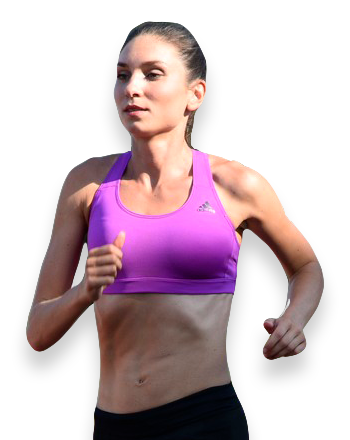
Matea Matošević
Hi, I’m Matea! I’m an Olympic Marathon Runner, founder, and writer behind OLYRUN.com. On this site, I provide help in the form of my knowledge and experience to all who love running and active living. Read more…
